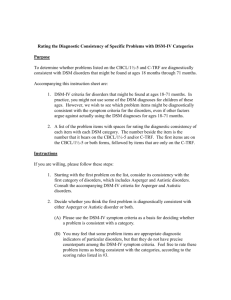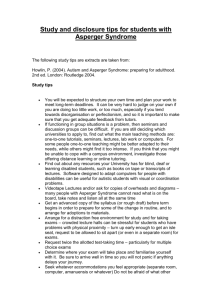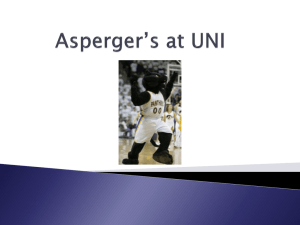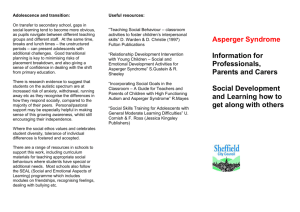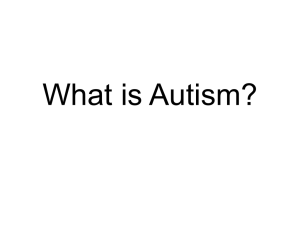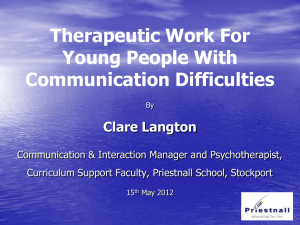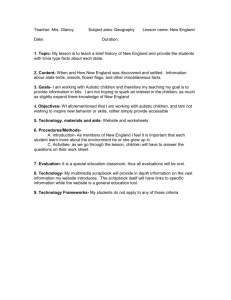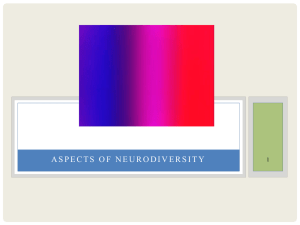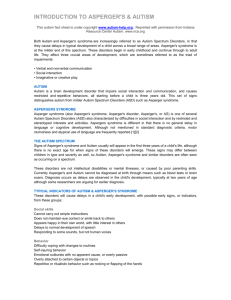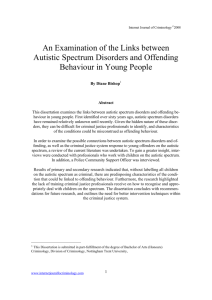docx - Health Vista
advertisement
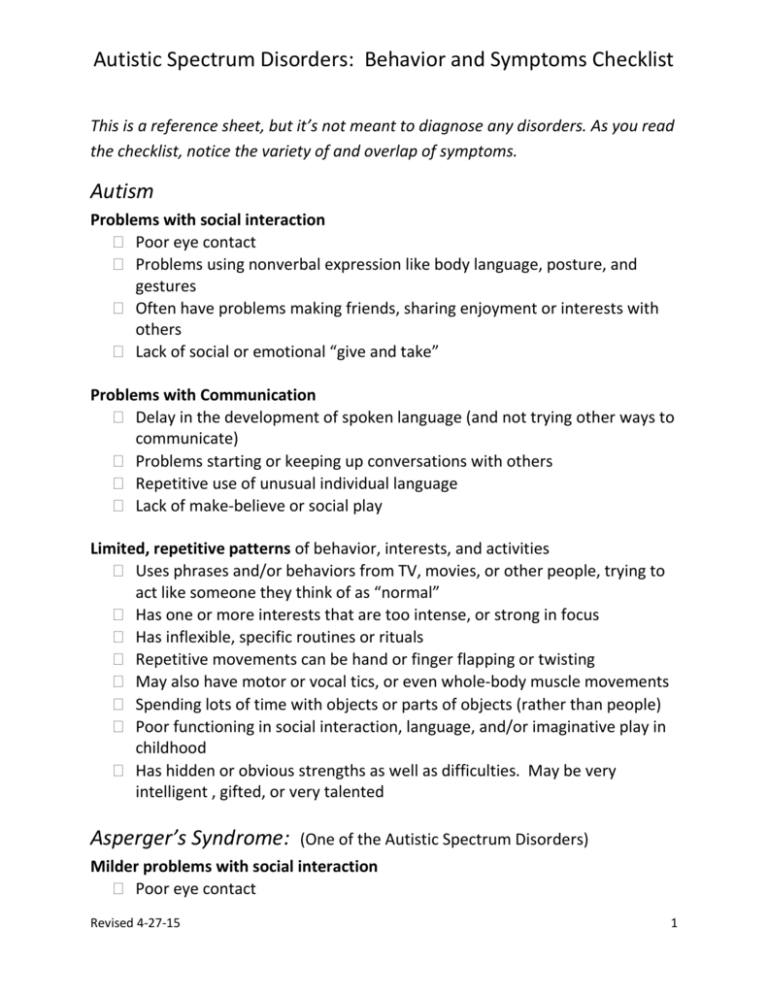
Autistic Spectrum Disorders: Behavior and Symptoms Checklist This is a reference sheet, but it’s not meant to diagnose any disorders. As you read the checklist, notice the variety of and overlap of symptoms. Autism Problems with social interaction Poor eye contact Problems using nonverbal expression like body language, posture, and gestures Often have problems making friends, sharing enjoyment or interests with others Lack of social or emotional “give and take” Problems with Communication Delay in the development of spoken language (and not trying other ways to communicate) Problems starting or keeping up conversations with others Repetitive use of unusual individual language Lack of make-believe or social play Limited, repetitive patterns of behavior, interests, and activities Uses phrases and/or behaviors from TV, movies, or other people, trying to act like someone they think of as “normal” Has one or more interests that are too intense, or strong in focus Has inflexible, specific routines or rituals Repetitive movements can be hand or finger flapping or twisting May also have motor or vocal tics, or even whole-body muscle movements Spending lots of time with objects or parts of objects (rather than people) Poor functioning in social interaction, language, and/or imaginative play in childhood Has hidden or obvious strengths as well as difficulties. May be very intelligent , gifted, or very talented Asperger’s Syndrome: (One of the Autistic Spectrum Disorders) Milder problems with social interaction Poor eye contact Revised 4-27-15 1 Autistic Spectrum Disorders: Behavior and Symptoms Checklist Milder problems with nonverbal expression, but good language skills Sometimes talking is monotone, a droning voice, or talking too much May have problems making friends or sharing enjoyment or interests with others Lack of social or emotional “give and take” May stand too close Limited range of interests, and activities Have a few interests that are intense or strongly focused Has inflexible, specific routines or rituals May have repetitive movements, like hand or finger flapping or twisting May also have motor or vocal tics, or even whole-body muscle movements Has problems in social, occupational, or other important areas of functioning, but no problem with language, intelligence, or self-help skills Has hidden or obvious strengths as well as difficulties. May be very intelligent , gifted, or very talented High-Functioning Autism: Non-Verbal Learning Disabilities (NVLD) Problems with integration of information Able to use language, but has trouble putting it all together and seeing the big picture – “Can’t see the forest for the trees.” Motor Coordination Problems Muscle movements may look clumsy or unbalanced, may avoid exploring things around them (Gross motor problems) Movements and grip of hands may be awkward, leading to poor handwriting, and problems with scissors (Fine motor problems) Visual/Spatial problems Trouble with figuring out visual images or information related to spaces May label things verbally to help themselves with coping, and to form routines – like finding places by counting houses, or verbally labeling landmarks May have a hard time finding where to write answers on tests or worksheets Revised 4-27-15 2 Autistic Spectrum Disorders: Behavior and Symptoms Checklist Social/communication problems: Trouble understanding non-verbal communication for social interaction. Difficulty getting the social acceptance they want (People with Asperger’s syndrome may appear uninterested socially, but want to have friends who accept them and fit into their perceived world. People with NVLD usually appear to want to make friends.) Sometimes other people may describe them as “annoying” or dependent Literally interprets what people say. Does not understand dishonesty or hidden meanings. May see the world in “black and white”. Misses social cues of give and take conversation. May seem self-centered, strange, or impolite at times. May appear confused when trying to adjust to change. Often have very good speaking skills, memory, and reading skills. Note: There is a lot of overlap in NVLD and Asperger’s Syndrome. Adapted from the following references: Kutscher, M. L. (n.d.). Autistic Spectrum Disorders: Sorting it out. Retrieved 8-19-09 from http://pediatricneurology.com/aspergers.pdf Dinklage, D. (2008). Aspergers Disorder and Non-Verbal Learning Disabilities: How Are These Two Disorders Related to Each Other? Retrieved 8-30-09 from AANE (Asperger's Association of New England) website at http://www.aane.org/asperger_resources/articles/miscellaneous/asperger_nonverbal_learning.html Thompson, S. (1996). Nonverbal learning disorders. Retrieved 8-30-09 from Online Asperger Syndrome Information and Support website at http://www.udel.edu/bkirby/asperger/NLD_SueThompson.html High-Functioning Autism: Semantic-Pragmatic Language Disorder (SPLD) Difficulty with semantics – (Problems using and understanding words, phrases and sentences) Abstract words, phrases that can mean more than one thing, or words about emotions are hardest. Difficulty with pragmatics – (Problems finding the main idea of what is being said, and trouble following rules of conversation. May seem to talk “at” you. Need for sameness and routine, since new situations may be overwhelming. Revised 4-27-15 3 Autistic Spectrum Disorders: Behavior and Symptoms Checklist May take everything literally, leading to confusion, anxiety, and social rejection. May have trouble with creative, imaginative, or symbolic play. May have some childhood speech delays that improve with therapy. May have good skills in math and computers, but poor writing and social skills. May “parrot back” more than they understand, so they may look smart and mature. May have some gross motor problem (imbalanced or uncoordinated), or fine motor muscle problems (some problems using their hands). They may have trouble knowing what is socially acceptable, but are usually not aggressive. May seem “odd” as children or teens, and may be “eccentric” as adults. Has trouble understanding what others are really thinking or feeling, but better social skills than people with Asperger’s syndrome. Hyperlexia Language problems Unusually good reading skills at a young age, but trouble with the meaning of the words, and their larger ideas. Problems with social rules of conversation, and may have unusual rhythm of speech. Socialization problems from failure to understand others, like anxiety, difficulty making friends, and having behavior rituals. Adapted from the following references: Bowen, C. (2001). Sematic and pragmatic difficulties and semantic pragmatic language disorder. Retrieved 8-30-09 from http://www.speech-language-therapy.com/spld.htm. in Kutscher, M. L. (n.d.). Autistic Spectrum Disorders: Sorting it out. Retrieved 8-19-09 from http://pediatricneurology.com/aspergers.pdf Revised 4-27-15 4
